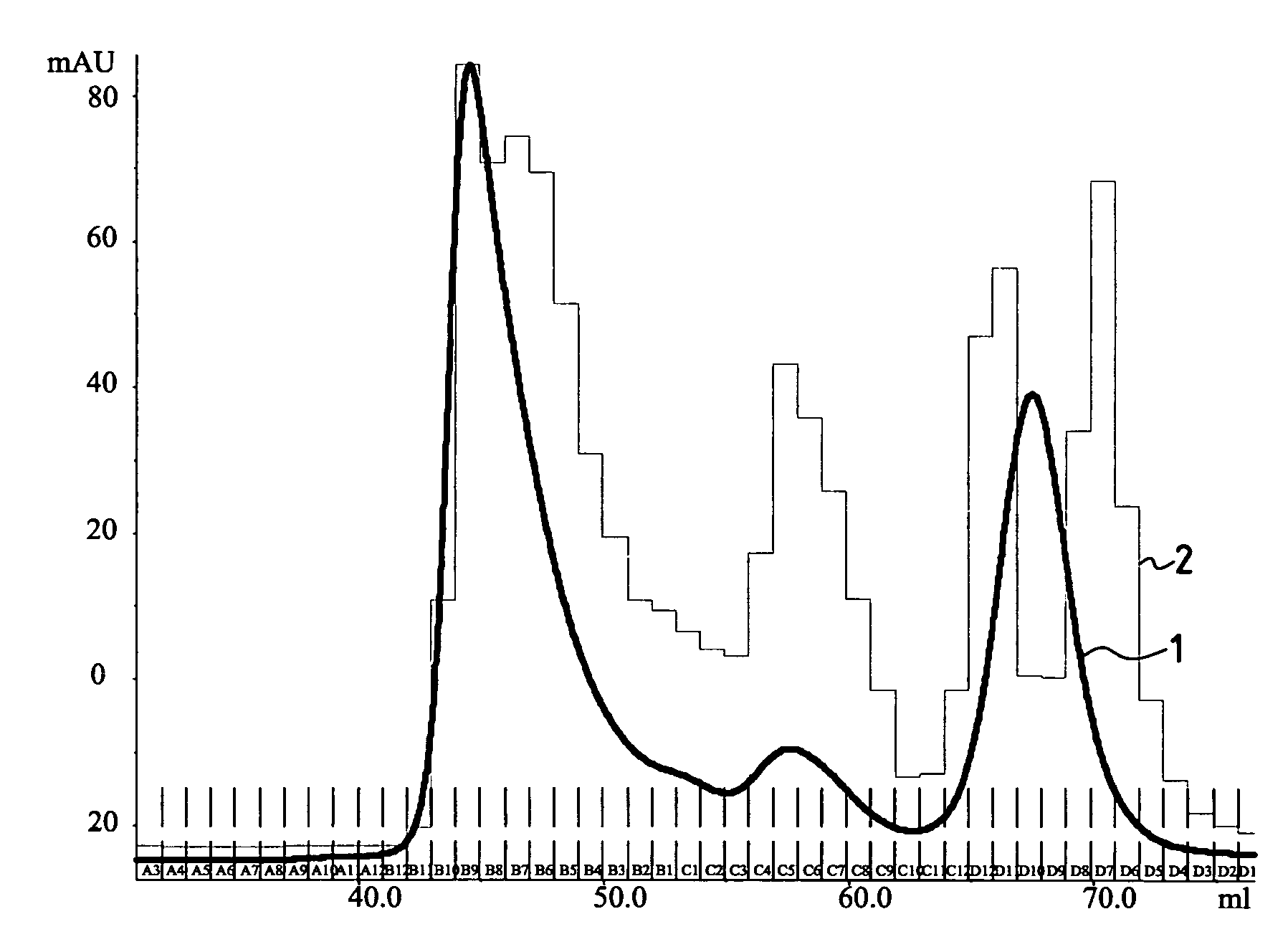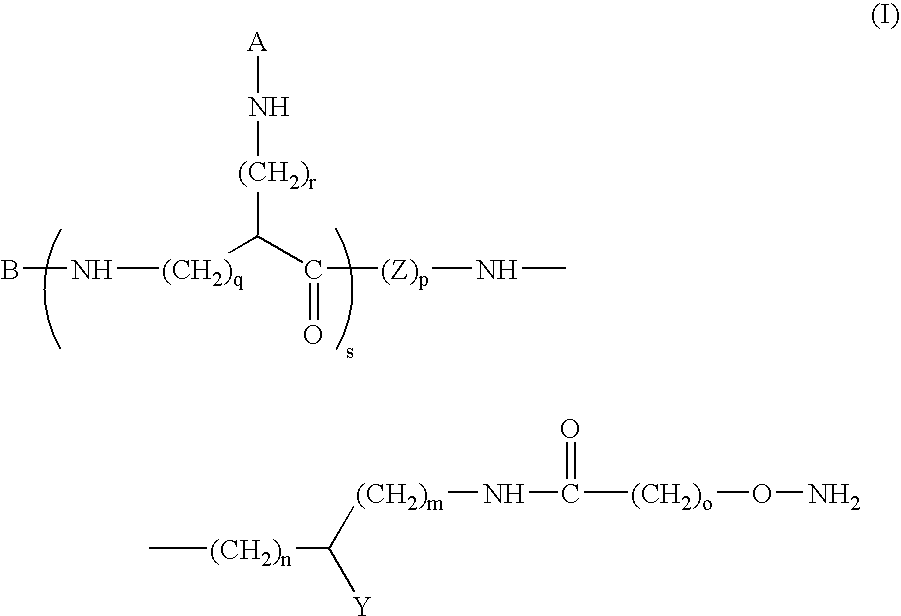Coupling agents, the active intermediates and the conjugates thereof and the use of said conjugates in diagnostic methods
a technology of active intermediates and coupling agents, applied in the field of heterofunctional coupling agents, can solve the problems of short synthesis method, scarce soluble aqueous media of coupling agents, and a tendency of proteins to precipitate during marking, and achieve the effects of high synthesis method, high soluble content, and sufficient distancing of coupled molecules
- Summary
- Abstract
- Description
- Claims
- Application Information
AI Technical Summary
Benefits of technology
Problems solved by technology
Method used
Image
Examples
example 1
[0104]Compound of formula (I) in which m=1, Y=—C(O)—NH2, o=1, n=0, p=2, s=0 and B represents:
[0105]
[0106]282 μmoles of Fmoc-RINK-Amide-MBHA resin (Novabiochem) were placed in the reactor of a 431 A automatic synthesizer (Applied Biosystems). Four cartridges of the three synthons I, II and TV were prepared containing ⅓ mmole of each synthon as follows:[0107]one cartridge containing 166.4 mg (approx. 333 μmol) of the following synthon (corresponding to synthon I):
[0108]
where Boc denotes t-butyloxycarbonyl and Fmoc denotes fluorenylmethoxycarbonyl,[0109]two cartridges each containing 128.5 mg (approx. 333 μmol) of synthon II:
[0110]
in which Fmoc is as defined above, and:[0111]one cartridge containing 56.4 mg (approx. 333 μmol) of synthon IV:
[0112]
[0113]The following coupling cycle was conducted four times with the aforesaid cartridges, in the following order:[0114]rinsing and et solvation of the resin with N-methylpyrrolidinone (NMP),[0115]dual treatment, for approximately 4 min, then f...
example 2
[0131]Compound of formula (I) in which: m=1, Y=—C(O)—NH2, o=1, n=0, p=2, r=4, s=1, q=0 and A and B are identical and represent:
[0132]
p1 equalling 2
[0133]To prepare the title compound, the operating mode described in example 1 was repeated, with the sole exception that the starting product was 153 μmol of reaction product between the resin, a cartridge of synthon I and two cartridges of synthon II such as described in example 1, and the following synthon cartridges were used:[0134]one cartridge containing approximately 166 μmol of the following synthon (corresponding to synthon III:
[0135]
in which Fmoc is such as defined above,[0136]four cartridges each containing approximately 333 μmol of synthon II:
[0137]
in which Fmoc is such as defined above, and[0138]two cartridges containing approximately 333 μmol of the following synthon IV:
[0139]
[0140]In this manner a product in gum form was obtained which was purified as indicated above except that the following gradient cycle was used:[0141]1...
example 3
Preparation of the Activated Intermediate gp 160 / Coupling Agent of the Invention
[0144]The glycoprotein gp160 (ABL) was dialysed overnight at 2–8° C. against a 50 mM acetate buffer pH 4.5 in the presence of 0.01% SDS. The glycoprotein obtained was oxidized with 5 mM NaIO4 in darkness for 15 min at 18–25° C. The reaction was blocked with ethyleneglycol ( 1 / 200) and the oxidized protein was dialysed against a 25 mM solution of sodium tetraborate pH 5.5.
[0145]A solution of the coupling agent was prepared as in example 2 with 2 mg / ml in a sodium tetraborate solution.
[0146]The coupling agent solution was mixed with the oxidized glycoprotein to the proportion of 20 mol coupling agent per 160 000 Da unit of glycoprotein and was incubated for one hour at 18–25° C. under stirring to achieve coupling.
[0147]The mixture obtained was dialysed against a 50 mM phosphate buffer, 150 mM NaCl, at pH 6.8.
PUM
| Property | Measurement | Unit |
|---|---|---|
| retention time | aaaaa | aaaaa |
| retention time | aaaaa | aaaaa |
| pH | aaaaa | aaaaa |
Abstract
Description
Claims
Application Information
 Login to view more
Login to view more - R&D Engineer
- R&D Manager
- IP Professional
- Industry Leading Data Capabilities
- Powerful AI technology
- Patent DNA Extraction
Browse by: Latest US Patents, China's latest patents, Technical Efficacy Thesaurus, Application Domain, Technology Topic.
© 2024 PatSnap. All rights reserved.Legal|Privacy policy|Modern Slavery Act Transparency Statement|Sitemap



